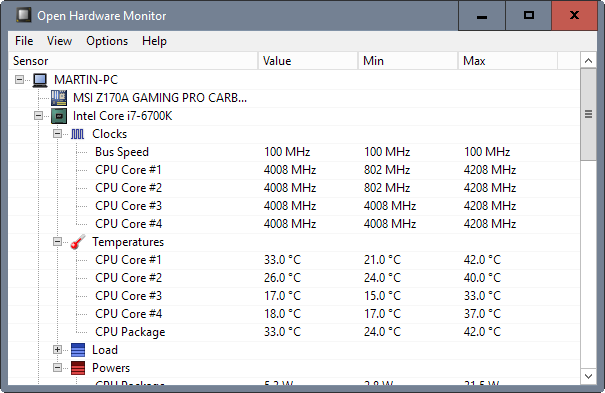Open Hardware Monitor 0.8 is out
Open Hardware Monitor 0.8 is the newest version of the popular computer hardware program for 32-bit and 64-bit versions of Microsoft Windows devices.
A jump to version 0.8 is usually not something that we write about unless new features or changed are introduced that make the news interesting to the majority of readers here on this site.
What makes the release of Open Hardware Monitor 0.8 interesting is the fact that it is the first release in over two years.
The program was well received before but many users probably thought that the project was dead due to the lack of updates. The new release changes that and gives hope that releases will be published more frequently again.
Open Hardware Monitor 0.8

You can download the program from the developer site. It is a portable application which means that you just need to extract it and may run it from any location right away without installation.
The interface of Open Hardware Monitor has not changed, and that is a good thing. The program displays the hardware of the PC on launch. Groups like the processor, memory, hard drives or the video card are listed each with one or multiple items or subgroups underneath them.
There is clocks, temperatures, load and powers for the processor alone for instance. Open Hardware Monitor keeps track of minimum, maximum and current values of items. This makes it easy to find out how hot a hard drive, the video card, or the processor really get, or the percentage of memory used when you ran some taxing programs.
Some advanced options, the saving of reports, the logging interval, or logging can be configured on top of that.
Open Hardware Monitor 0.8 Changes
The new version of Open Hardware Monitor is all about support improvements. The program supports the following devices, device families or sensors in the new version:
- Intel Skylake, Kaby Lake and Airmont CPUs
- Intel Xeon E5-26xx v4 and Xeon D-15xx CPUs.
- Intel Intel i5, i7 5xxC (14nm) CPUs.
- AMD family 15h model 30h APUs.
- ITE IT8620E and IT8628E super I/O chips.
- Nuvoton NCT6102D/NCT6106D super I/O chips.
- Better Nvidia RAM sensors (free, used and total) support.
- More sensors for Samsung and Plextor SSDs.
A couple of issues were corrected on top of that. The new version fixes wrong Nvidia GPU clock min and plotting values, issues with Nuvoton NCT6791D super I/O chips after wake from S3 sleep state, and incorrect OS version showing up in reports on Windows 10 and 8.1 PCs.
Closing Words
Support for new Intel and AMD processors, and other hardware devices and sensors improves the program's usability as it detects these cpus and devices correctly now. So, better support without any unnecessary interface changes or experiments.